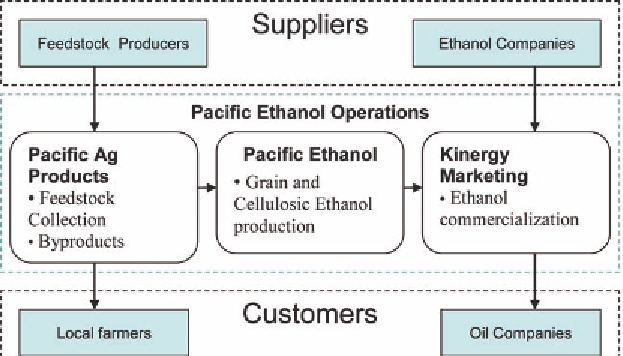Environmental Engineering Reference
In-Depth Information
Alliances
Pacific Ethanol Business Model
Another component of the strategy is establishing
alliances with other players in the bioenergy in-
dustry for evaluating strategic opportunities in the
development of ethanol production facilities and
in storage and distribution infrastructure. Pacific
Ethanol has applied for and received 25 million
in federal funding; from a total of 39 contestants
only 4 grants were awarded. This pilot cellulosic
ethanol plant is a result of a combination of gov-
ernmental incentive, technology from BioGasol,
and support from the Joint Bionergy Institute
(Davis, 2008b).
The institutions taking part in the DOE's
Joint Bioenergy Institute are Lawrence Berkeley
National Laboratory (LBNL), Sandia National
Laboratories (SNL) and Lawrence Livermore
National Laboratory (LLNL); additionally other
contributing institutions are the University of
California, Berkeley (UCB), the University of
California, Davis (UCD) and Stanford University
(Joint Bioenergy Institute, n.d.).
Pacific Ethanol operations are divided in three
operational companies, each one with a clearly
defined area of operation in the supply chain.
The advantage of this business model (Figure
3) is that Pacific Ethanol can provide services to
other ethanol producers and different players in
the bioenergy industry (Pacific Ethanol Inc., n.d.).
Pacific Ag Products
This branch is a subsidiary of Pacific Ethanol that
handles the marketing and distribution of grain
products for the Company. Corn receiving and
grain mill operations at Front Range Energy in
Windsor, Colorado as well as all Pacific Ethanol
plants are handled by Pacific Ag Products. This
subsidiary is also responsible for marketing all
Wet Distillers Grain produced by the plants and
Front Range Energy.
In the ethanol production process, after a grain's
starch is converted to ethanol through fermenta-
tion, the remaining nutrients are concentrated into
wet distillers grain (WDG). WDG is an excellent
feed for cattle, poultry and swine (Davis, 2008b).
Figure 3. Pacific Ethanol Business Model

